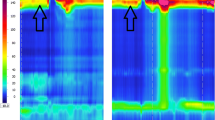Abstract
Background
The Bravo catheter-free pH monitoring system uses a capsule attached to the esophageal mucosa to detect acid exposure. Placement of the Bravo capsule is associated with intermittent chest pain in 50% of normal volunteers. The authors hypothesized that chest pain in this setting may be attributable to hypertensive esophageal contractions induced by the Bravo capsule.
Methods
The study population consisted of 40 consecutive patients with reflux symptoms who had stationary esophageal manometry within 1 h after Bravo capsule placement. The control group consisted of 40 patients with symptomatic gastroesophageal reflux disease (GERD) from a population of patients with foregut symptoms who were computer matched to the study group for age, sex, lower esophageal sphincter (LES) pressure, LES length, and 24-h pH composite score. The patients in the control group had manometry before Bravo capsule placement. The occurrence of chest pain was assessed before and during the monitoring period by interview and review of the patient’s diary. Mean contraction amplitudes in the distal third of the esophagus after 10 wet swallows were averaged. The prevalence of patients with esophageal contraction amplitudes in the distal third that exceeded the 95th percentile of normal (180 mmHg) and the mean amplitude of distal third esophageal contractions in the study and control populations were compared. In the study group, the incidence of chest pain among the patients with hypercontractility of the esophagus was compared with the incidence among those without hypercontractility.
Results
The mean contraction amplitude was higher in the study group (144.7 vs 105.5 mmHg; p = 0.002). The number of patients with a mean distal esophageal contraction amplitude exceeding the 95th percentile of normal also was significantly higher in the study group (13/40 vs 5/40; p = 0.03). A total of 10 patients experienced new onset of chest pain with the Bravo capsule in place, and 6 patients experienced hypertensive esophageal contractions.
Conclusions
The intraesophageal Bravo capsule can cause hypertensive esophageal contractions, which may lead to chest pain.






Similar content being viewed by others
References
Fass R, Hell R, Sampliner RE, Pulliam G, Graver E, Hartz V, Johnson C, Jaffe P (1999) Effect of ambulatory 24-hour esophageal pHmonitoring on provoking activities. Dig Dis Sci 44: 2263–2269
Pandolfino JE, Richter JE, Ours T, Guardino JM, Chapman J, Kahrilas PJ (2003) Ambulatory esophageal pHmonitoring using a wireless system. Am J Gastroenterol 98: 740–749
Wong WM, Bautista J, Dekel R, Malagon IB, Tuchinsky I, Green C, Dickman R, Esquivel R, Fass R (2005) Feasibility and tolerability of transnasal/per oral placement of the wireless pH capsule vs traditional 24-h oesophageal pH monitoring: a randomized trial. Aliment Pharmacol Ther 21: 155–163
Kahrilas PJ, Lin S, Chen J, Manka M (1999)The effect of hiatus hernia on gastroesophageal junction pressure. Gut 44: 476–482
Pilhall M, Borjesson M, Rolny P, Mannheimer C (2002) Diagnosis of nutcracker esophagus, segmental or diffuse hypertensive patterns, and clinical characteristics. Dig Dis Sci 47: 1381–1388
Brand DL, Martin D, Pope CE II (1977) Esophageal manometrics in patients with angina-like chest pain. Am J Dig Dis 22: 300–304
Chobanian SJ, Benjamin SB, Curtis DJ, Cattau EL Jr (1986) Systematic esophageal evaluation of patients with noncardiac chest pain. Arch Intern Med 146: 1505–1508
Katz PO, Dalton CB, Richter JE, Wu WC, Castell DO (1987) Esophageal testing of patients with noncardiac chest pain or dysphagia. Ann Intern Med 106: 593–597
Traube M, Albibi R, McCallum RW (1983) High-amplitude peristaltic esophagesl contractions associated with chest pain. JAMA 250: 2655–2659
Lin E, Waring JP, Ramaswamy A (2003) Analysis of 245 consecutive studies using 48-hour wireless pH(Bravo) probes for GERD evaluation. Gastroenterology 124:A689
Author information
Authors and Affiliations
Corresponding author
Additional information
Presented at the Society of American Gastrointestinal and Endoscopic Surgeons (SAGES) meeting, Hollywood, FL, USA, 13–16 April 2005
Rights and permissions
About this article
Cite this article
Tharavej, C., Hagen, J.A., Portale, G. et al. Bravo capsule induction of esophageal hypercontractility and chest pain. Surg Endosc 20, 783–786 (2006). https://doi.org/10.1007/s00464-005-0257-8
Received:
Accepted:
Published:
Issue Date:
DOI: https://doi.org/10.1007/s00464-005-0257-8




